“It is the brain, not the heart or lungs, that is the critical organ; it’s the brain”
~Sir Roger Bannister
 In a previous post, we talked about developing and writing goals for the coming season. While physical training is an important part of achieving these goals, it is just one element to achieving your season goals.
In a previous post, we talked about developing and writing goals for the coming season. While physical training is an important part of achieving these goals, it is just one element to achieving your season goals.
Mental fitness and motivation are required for breakthrough performances. In this regard, Bannister is absolutely correct: the brain is, indeed, the critical organ.
And, it’s not just our opinion. Sport science confirms the old adage: what the mind believes, the body achieves.
This post begins a 3-part discussion of this topic. Part 1, which we have for you here, looks at the motivation of endurance athletes, and the ways in which motivation contributes to our longevity in and enjoyment of endurance sport. Part 2 discusses how and why the brain plays such a pivotal role in your mental strength. Part 3 features strategies for increasing your mental toughness in training and racing.
As you no doubt already know, endurance athletes are a diverse (and slightly crazy but very loveable) group.We are motivated by a combination of things. The three most popular motivations found within the research include: 1) achievement, 2) social belonging and 3) self-determination. Let’s consider each of these.
Theories of Motivation
Achievement goal theory predicts that our motivation comes from a desire to demonstrate ability, to ourselves or others (Hodge, Allen & Smellie, 2008). According to this model, we judge our success based on our perception of our ability as high or low, and we make this judgment based on individual accomplishments, which is a task orientation, or in comparison to the accomplishments of others, which is an ego-orientation.

For example, an athlete with a task orientation may set a goal to PR a previous race attempt, or to finish her first Ironman or marathon. In this case, the athlete judges success upon her own personal performance, and compares it to her previous performances.
An athlete with an ego-orientation may set a goal to win his age group, or to place in the top ten of a race. In this case, the athlete is basing his success upon the actions of others in the same or similar events.
Most athletes will likely have a mix of these two orientations, and it’s more appropriate to see it as a continuum rather than a strict either-or standpoint. However, which of these orientations dominates does offer some insight into the enjoyment of and long term participation in endurance sport.
Athletes with task-oriented motivations tend to be intrinsically motivated, which means they perceive a value that comes from within, and do not need much external recognition or reward. This orientation typically leads to with higher levels of enjoyment and long-term participation in the sport.
On the other hand, athletes with ego-orientations are more extrinsically motivated, which means that at least part of their motivation comes from external recognition and reward. The research suggests that when this viewpoint dominates, the athlete may experience less enjoyment in the sport since their markers of success are dependent upon the actions of others and external recognition. As enjoyment dissipates, so too does the likelihood of sticking with the activity.
Of course, not all motivations come from the need for achievement. Social motives are also important, particularly for recreational athletes. The social motivation model examines the role of social affiliation, status and recognition for predicting participation in sport. For example, most recreational runners report social motivation as the reason for running. For first-timers, females, and masters athletes, this is especially true. This motivation explains the value of triathlon clubs, running groups, and group training for many athletes. It affords a sense of social belonging, and camaraderie which lends to enjoyment as well as accountability.

Self-determination theory pulls together the ideas of achievement theory and social motivation theory, looking at motivational triggers and social needs. The theory predicts that athletes who have high perceptions of their ability and a strong sense of belonging in the sport community will be the most intrinsically motivated, and hence most likely to enjoy and stay committed to the endurance lifestyle. In a study of almost 400 masters athletes, this prediction was supported (Hodge, Allen & Smellie, 2008).
In addition to the level of commitment and enjoyment from the sport, researchers have found correlations between motivation orientations and performance. The studies consistently find a correlation between our goals and outcomes. While a correlation is not definitive proof or causation, it demonstrates that the connection between our mental and physical fitness is important.
In a study of marathon runners, Ogles & Masters (2003) found five categories of motivational orientations: running enthusiasts, lifestyle managers, personal accomplishers, personal goal achievers, and competitive achievers. Among these groupings, the personal goal achievers and the competitive achievers tend to have the fastest marathon finishing times, with motivations based on goal achievement either in terms of their individual achievement (task orientation) or in competition with others (ego orientation). Regardless of ability, however, all of these categories emphasize personal goal achievement as an important reason why they run, which tends to support their enjoyment and intention to continue participating in the sport.
Of course, not everyone who starts on a training program, sticks with it. To determine the motivational differences that might be seen between first time marathon finishers and those who dropped out of a training program, Havenar & Lochbaum (2007) conducted a study of 106 participants, 31 of which finished a marathon. The authors found that those who didn’t finish were more likely to have either social motives, such as social recognition or affiliation, or weight concerns than those that did complete the training and marathon. This is a somewhat curious finding as social affiliation and/or support has been found to increase the likelihood to stick with exercise. So, the authors surmise that marathon training did not meet these needs for whatever reason, or that the perceived costs of marathon training were not worth the perceived benefits.
While we cannot necessarily change our motivation, we can better understand how they support us in the journey to achieve our goals. In part 2 of our mental fitness series, we will go beyond the role of motivation to examine how our mind affects our performances, taking a look at the central governor model and the role of self-efficacy. Part 3 will focus on the mental strategies we use to cope with challenging and painful workouts or races.
*~*~*~*~*~*~*~*~*~*~*~*~*~*~*~*~*~*~*
What motivates you?
*~*~*~*~*~*~*~*~*~*~*~*~*~*~*~*~*~*~*
References
Havenar, J., & Lochbaum, M. (2007). Differences in participation motives of first-time marathon finishers and pre-race dropouts. Journal of Sport Behavior, 30(3), 271-279.
Hodge, K., Allen, J.B., Smellie, L. (2008). Motivation in masters sport: Achievement and social goals. Pyschology of Sport and Exercise, 9, 157-176.
Luszczynska, A., Mazurkiewicz, M., Ziegelmann, J.P., and Schwarzer, R. (2007). Recovery self-efficacy and intention as predictors of running or jogging behavior: A cross-lagged panel analysis over a two-year period. Psychology of Sport and Exercise, 8, 247-260.
Ogles, B.M., and Masters, K.S. (2003). A typology of marathon runners based on cluster analysis of motivations. Journal of Sport Behavior, 26(1), 69-85.
Noakes, T.D. (2007). The central governor model of exercise regulation applied to the marathon. Sports Medicine, 37(4-5), 374-377.
